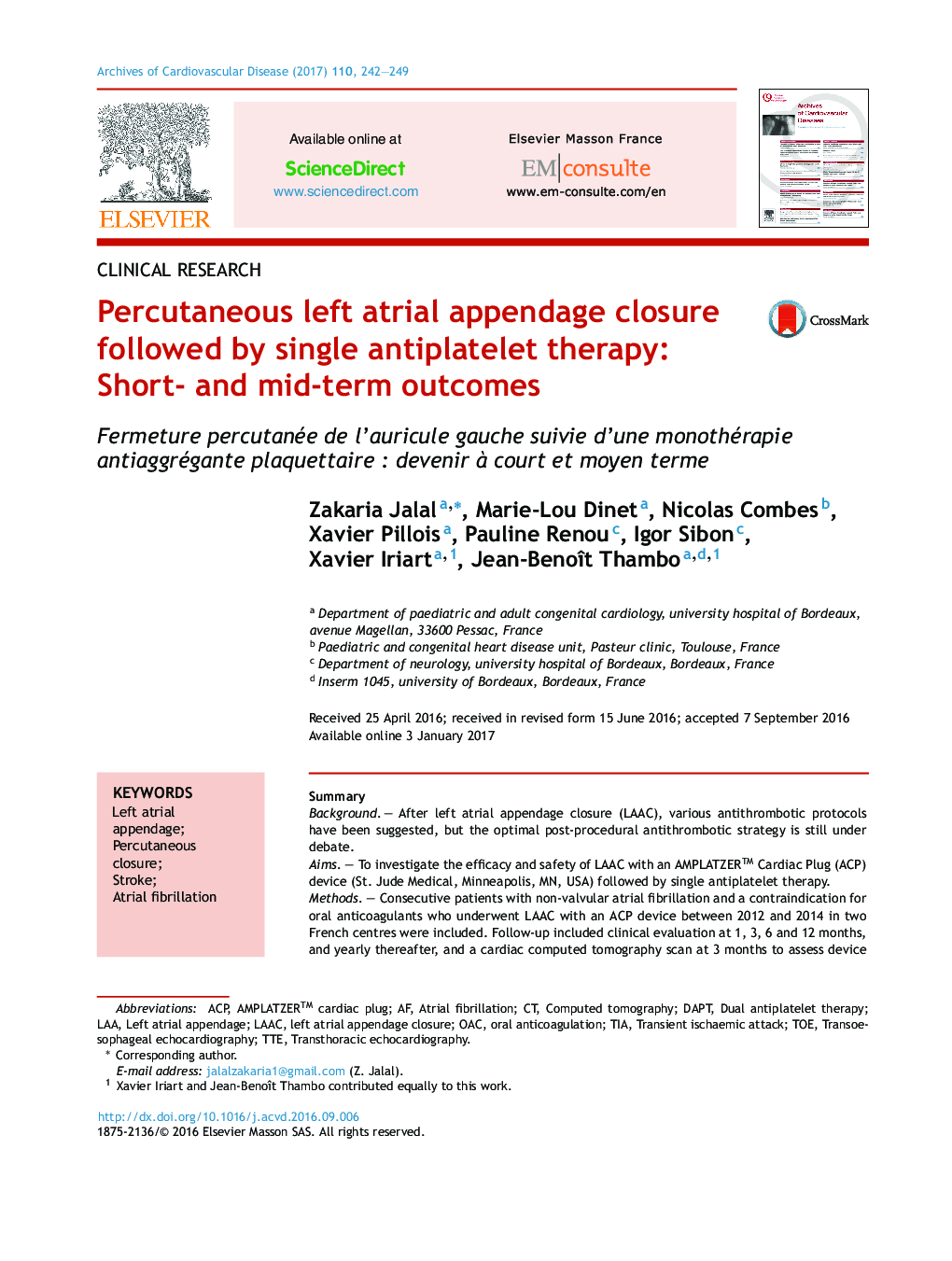| کد مقاله | کد نشریه | سال انتشار | مقاله انگلیسی | نسخه تمام متن |
|---|---|---|---|---|
| 5598719 | 1574325 | 2017 | 8 صفحه PDF | دانلود رایگان |

SummaryBackgroundAfter left atrial appendage closure (LAAC), various antithrombotic protocols have been suggested, but the optimal post-procedural antithrombotic strategy is still under debate.AimsTo investigate the efficacy and safety of LAAC with an AMPLATZER⢠Cardiac Plug (ACP) device (St. Jude Medical, Minneapolis, MN, USA) followed by single antiplatelet therapy.MethodsConsecutive patients with non-valvular atrial fibrillation and a contraindication for oral anticoagulants who underwent LAAC with an ACP device between 2012 and 2014 in two French centres were included. Follow-up included clinical evaluation at 1, 3, 6 and 12 months, and yearly thereafter, and a cardiac computed tomography scan at 3 months to assess device position, device-related thrombus and residual leak. Single antiplatelet therapy was prescribed after the procedure for at least 12 months.ResultsA total of 76 patients underwent successful LAAC (mean age: 73 years; 59% men; mean CHA2DS2-VASc score 4.4 ± 1.3; mean HAS-BLED score 3.4 ± 0.9). Three major complications occurred during the periprocedural period (one cardiac tamponade and two access site haematomas). Device thrombosis was observed at 3 months in five (6.8%) patients who remained asymptomatic. After a mean follow-up of 13 months, the rates of death, stroke and major bleeding were 2.6%, 4.0% and 1.3%, respectively. Embolic and bleeding events were less frequent than expected from CHA2DS2-VASc (4.0% vs 9.9%; P < 0.001) and HAS-BLED (1.3% vs 4.3%; P < 0.001) risk scores.ConclusionsLAAC using an ACP device followed by single antiplatelet therapy could be a reasonable alternative for stroke prevention.
RésuméContexteAprès la fermeture percutanée de l'auricule gauche (FPAG), plusieurs protocoles antithrombotiques ont été suggérés mais la stratégie optimale de traitement antithrombotique reste débattue.ObjectifsÃvaluer l'efficacité et l'innocuité de la FPAG avec les dispositifs Amplatzer Cardiac Plug (St. Jude Medical, Minneapolis, Minnesota) (ACP) suivie d'une monothérapie antiagrégante plaquettaire.MéthodesLes patients consécutifs ayant une fibrillation atriale non-valvulaire et une contre-indication aux anticoagulants oraux et ayant bénéficié d'une FPAG avec un dispositif ACP entre 2012 et 2014 dans 2 centres français étaient inclus. Le suivi comportait une évaluation clinique à 1, 3, 6 et 12 mois, puis de manière annuelle ainsi qu'une tomodensitométrie cardiaque à 3 mois pour évaluer la position de la prothèse, la présence d'un éventuel thrombus ou une fuite résiduelle. Une monothérapie antiagrégante était prescrite après la procédure pour au moins 12 mois.RésultatsAu total, 76 patients ont bénéficié une d'FPAG avec succès (âge : 73 ans, 59 % d'hommes, CHA2DS2-VASc score moyen 4,4 ± 1,3, HAS-BLED score moyen 3,4 ± 0,9). Trois complications majeures sont survenues durant la période periprocédurale (1 tamponnade et 2 complications hémorragiques au point de ponction). Un thrombus sur le dispositif était observé à 3 mois chez 5 patients (6,8 %) par ailleurs asymptomatiques. Après un suivi moyen de 13 mois, les taux de décès, d'accidents emboliques et hémorragiques étaient de 2,6 %, 4,0 % et 1,3 %, respectivement. Les évènements emboliques et hémorragiques étaient moins fréquents que le prédisaient les scores de CHA2DS2-VASc (4,0 % vs 9,9 % ; p < 0,001) et HAS-BLED (1,3 % vs 4,3 % ; p < 0,001).ConclusionsLa fermeture percutanée de l'auricule gauche avec les dispositifs ACP suivie d'une monothérapie antiagrégante peut constituer une alternative raisonnable pour la prévention des accidents emboliques.
Journal: Archives of Cardiovascular Diseases - Volume 110, Issue 4, April 2017, Pages 242-249